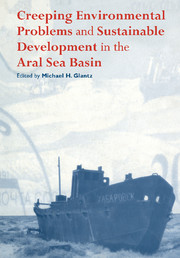Book contents
- Frontmatter
- Contents
- List of contributors
- Introduction
- 1 Sustainable development and creeping environmental problems in the Aral Sea region
- 2 Ecological disaster linked to landscape composition changes in the Aral Sea basin
- 3 Alteration of water level and salinity of the Aral Sea
- 4 Desertification in the Aral Sea region
- 5 Climate fluctuations and change in the Aral Sea basin within the last 50 years
- 6 Priaralye ecosystems and creeping environmental changes in the Aral Sea
- 7 Public health in the Aral Sea coastal region and the dynamics of changes in the ecological situation
- 8 The impact of political ideology on creeping environmental changes in the Aral Sea basin
- 9 Change of the rivers' flow in the Aral Sea basin (in connection with the problem of quantitative assessment and consideration of environmental after-effects)
- 10 Fish population as an ecosystem component and economic object in the Aral Sea basin
- 11 Creeping environmental changes in the Karakum Canal's zone of impact
- 12 Environmental changes in the Uzbek part of the Aral Sea basin
- 13 Creeping changes in biological communities in the Aral Sea
- Index
3 - Alteration of water level and salinity of the Aral Sea
Published online by Cambridge University Press: 19 October 2009
- Frontmatter
- Contents
- List of contributors
- Introduction
- 1 Sustainable development and creeping environmental problems in the Aral Sea region
- 2 Ecological disaster linked to landscape composition changes in the Aral Sea basin
- 3 Alteration of water level and salinity of the Aral Sea
- 4 Desertification in the Aral Sea region
- 5 Climate fluctuations and change in the Aral Sea basin within the last 50 years
- 6 Priaralye ecosystems and creeping environmental changes in the Aral Sea
- 7 Public health in the Aral Sea coastal region and the dynamics of changes in the ecological situation
- 8 The impact of political ideology on creeping environmental changes in the Aral Sea basin
- 9 Change of the rivers' flow in the Aral Sea basin (in connection with the problem of quantitative assessment and consideration of environmental after-effects)
- 10 Fish population as an ecosystem component and economic object in the Aral Sea basin
- 11 Creeping environmental changes in the Karakum Canal's zone of impact
- 12 Environmental changes in the Uzbek part of the Aral Sea basin
- 13 Creeping changes in biological communities in the Aral Sea
- Index
Summary
Background up to the twentieth century
The Aral Sea is the largest inland drainless water body with specific marine and lacustrine features located in the Central Asian deserts – in the Turanskaya Lowland, near the eastern edge of the Ustyurt Plateau. The water and salt budgets, the level and areal extent of the sea, the water salinity level, as well as other characteristics of the sea, are completely determined by the streamflow of Central Asia's two major rivers, the Amudarya and the Syrdarya. The amount of surface water flow into the Aral Sea depends on (a) the impacts of climate-related fluctuations of the natural water supply of these rivers and (b) on the steadily growing anthropogenic demands on the rivers' waters during the twentieth century (e.g., the consumptive withdrawals of river water mainly to meet the demands of irrigated farming).
Changes in the regime of the Aral Sea are determined primarily by alterations of two of its key characteristics: its height above sea level and the average level of mineralization of its water (i.e., salinity). The sea's level depends on the volume of water that accumulates in its basin. The average salinity of the sea's water is governed by the relationship between the mass of salts dissolved in the water and the volume (rather, the mass) of sea water.
Paleo studies indicate that there have been significant, age-old cyclical alterations of Aral Sea level and salinity throughout its history. For example, the range of sea level fluctuations during the Holocene apparently exceeded 20 meters.
- Type
- Chapter
- Information
- Publisher: Cambridge University PressPrint publication year: 1999
- 11
- Cited by



